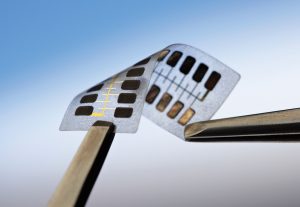
Security innovations ensure product authenticity, consumer safety
By Dr. Paul Smith, vice-president & centre manager, Xerox Research Centre of Canada (XRCC), Mississauga ON
Electronics Production / Materials Engineering Printable Electronics Supply Chain Wearable Technology printed electronicsThe engineers and scientists at the Xerox Research Centre of Canada (XRCC) spend much of their time helping companies come up with innovative security solutions to battle counterfeits and protect their brands against pirates — an enormous challenge with an annual global price tag of $1.7-trillion, according to the Organization for Economic Development.

Xerox Printed Memory and Xerox Printed Memory with Cryptographic Security is a highly secure, flexible printed label which can be used to determine if a product is genuine and to track how it has been handled during distribution.
To illustrate how companies can circumvent the issue of counterfeiting, consider a recent example of a firm that worked with Xerox Canada’s Graphics Communications Operations to crack a unique pharmaceutical security challenge that required a creative solution.
The OTC Group in London ON is a high-performance packaging and data company that provides brand marketers and retailers cost-effective, high-speed packaging and promotion solutions with customization and personalization.
OTC Group needed to come up with a solution for pharmaceutical clients to prevent package theft and counterfeiting, while adhering to stringent requirements the U.S. government introduced to track and trace packaging. Not only do theft and fake packaging cost the pharmaceutical industry an estimated $75-billion to $200-billion globally each year, but they also endanger human lives.
Xerox has a printed electronics solution that can add intelligence
and anti-counterfeiting measures to any package
Traditionally, packaging companies have tried to guard against pharmaceutical counterfeiting by using an inkjet process to apply identifiers in the final stages of manufacturing. But this method has been insufficient and leaves ample opportunity for fraud, especially when package printing and assembly are provided by outside vendors.
The OTC Group and Xerox collaborated to create an innovative workflow process and packaging approach that guarantees security. The process combines OTC group software and the Xerox Automated Packaging Solution (XAPS). This allows the OTC Group to produce folded cartons with advanced anti-counterfeiting measures, as well as unique product information for tracking and tracing, at the beginning of the printing process.
The solution goes beyond legal requirements, and can save clients millions. For example, a client recently required an 800,000 printed carton production run and OTC Group estimates that the solution eliminated millions of dollars of risk exposure by providing traceability at every level, with the ability to account for every package printed – including waste – and providing that data to the client.
Xerox also has a printed electronics solution that can add intelligence and anti-counterfeiting measures to any package.
Xerox Printed Memory consists of thin micro-circuits on a label that is a thin film of plastic adhesive. Each digital label holds as much as 36 bits of re-writable memory and can store up to 68 billion distinct data combinations. Data is preserved until overwritten within a 10-year span. Everything from lot codes and serial numbers to expiration dates and geographic codes can be stored on it.
Printed Memory can be beefed up with optional tamper-evident
adhesives and a cryptographic feature
These digital labels can measure and count. For instance, this information can tell you when a water filter must be changed, or if a compliant part is being used in a medical device. And, because the memory labels are manufactured by a printing process, the cost is dramatically lower than those technologies based on RFID or silicon chip technology.
An inexpensive contact device is used to write and read the labels. To meet the many unique applications and uses, a customized reader can be designed based on user requirements. It can be an external reader to read the memory on packages or it can be integrated into a dispensing unit for use in Smart Consumables.
Adding even greater security, Xerox Printed Memory can be beefed up with optional tamper-evident adhesives and a cryptographic feature that includes barcodes or QR codes.
Protecting brand and packaging is important in every industry. But it’s critical for those in pharmaceutical, government and any industry concerned with gray market sales, counterfeiting and supply chain integrity. Of course, the end-user is also a beneficiary as well, having the peace of mind that their products are safe and genuine.
